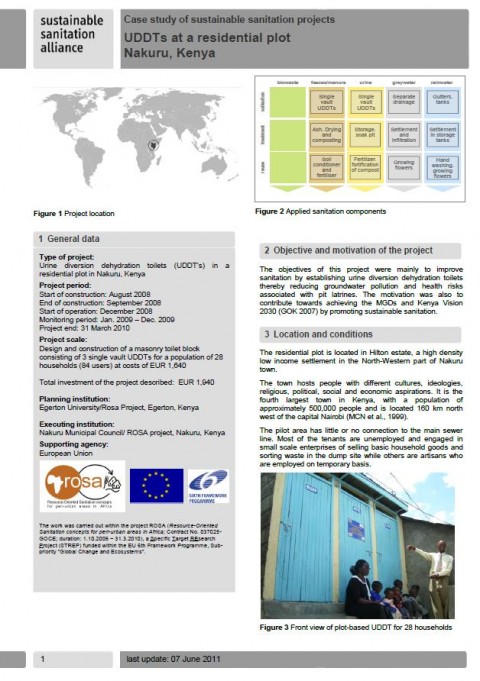UDDTs at a residential plot Nakuru, Kenya - London estaste. Case study of SuSanA
Muchiri, E., Mutua, B. (2010)

Published in: 2010
Publisher:
Sustainable Sanitation Alliance (SuSanA)
Author:
Muchiri, E., Mutua, B.
Uploaded by:
SuSanA secretariat
Partner profile:
common upload
12522 Views
144 Downloads
Location of library entry
Content - Summary
This SuSanA case study compiles experiences from a ROSA sanitation pilot project for a residential plot in Nakuru, Kenya. 3 single vault UDDTs were constructed to serve a population of 28 households. The urine is soaked away and the faecal material collected by trained local waste collectors. A drying shed was constructed for this purpose. The facilities were monitored and evaluated after about 3 years of operation showing some challenges in the service provision for collection of faecal material. A follow up saniation program called CLARA will address the challenges witnessed in this peri-urban area.
The objectives of this project were mainly to improve sanitation by establishing urine diversion dehydration toilets thereby reducing groundwater pollution and health risks associated with pit latrines. The motivation was also to contribute towards achieving the MGDs and Kenya Vision 2030 (GOK 2007) by promoting sustainable sanitation.
The UDDT was generally well maintained most of the time. Smell was detected and flies noticed 4 times of the 20 times visited by project staff. The main operation problem observed was the misuse of the toilets by visitors and strangers who were not familiar with the proper use, leading to mixing of urine and faeces. The children were also reported to put ash into the urine hole occasionally leading to blockage of the
system.
To solve these problems, a new toilet management system has been put in place where the 3 UDDTs are divided among the 28 households, who are supposed to take care and maintain the toilets. The toilets are now closed and each group has their own keys.
For long term sustainability and for economic sanitation, the following is recommended:
Encourage the landlord to have a sense of ownership and to ensure good operation, maintenance and management
Encourage users to correct use and to spread the knowledge of the ROSA system to the communities they live in, so as to create a critical mass.
To demonstrate the additional economic benefits arising from the utilisation of the products, this is an important factor in the success of the system.
To carry out pathogen tests at different stages of the faecal storage to determine health effects of handling faeces and urine during collection, transportation, treatment and reuse. This is meant to serve as a source
of researched information that can be used in the decision making on utilisation of products. To confirm the calculated costs of operation and
maintenance with the actual costs.
Bibliographic information
Muchiri, E., Mutua, B. (2010). UDDTs at a residential plot Nakuru, Kenya - London estaste. Case study of SuSanA. Sustainable Sanitation Alliance (SuSanA)
Filter tags
Case studies in SuSanA template English Peri-urban Sub-Saharan Africa Urine diversion dehydration toilets (UDDTs)















